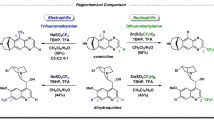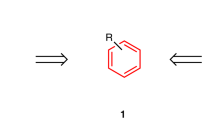Abstract
IT has now become abundantly clear that in ethylene (CH2=CH2) one of the two bonds is of the normal covalent type (σ-bond), while the other belongs to a distinct and separate class (π-bond). Thermochemical studies have further revealed that the bond-strength of a C=C double bond is appreciably less than twice the value for a C—C single bond, showing that the π-bond is not as strong as the σ-bond. Thus it was quite natural to assume that addition reactions occur by the direct rupture of the weaker π-bond. However, it has been found that addition proceeds generally in the trans sense, which is exactly contrary to expectation. The reactivity towards addition reactions also decreases unexpectedly with increase in the number of σ-bonds (except in conjugation). Acetylene (CH≡CH) with two π-bonds is less reactive than ethylene1. The first stage addition to one of the cumulated double bonds in allene (CH2=C=CH2), which is expected to be very much strained, is also much slower than the second stage addition to its remaining simple double bond2. It is remarkable that higher cumulenes (>C=C=C=C=C=C<) are quite stable3.
This is a preview of subscription content, access via your institution
Access options
Subscribe to this journal
Receive 51 print issues and online access
$199.00 per year
only $3.90 per issue
Buy this article
- Purchase on Springer Link
- Instant access to full article PDF
Prices may be subject to local taxes which are calculated during checkout
Similar content being viewed by others
References
Robertson, P. W., Dasent, W. E., Milburn, R. M., and Oliver, W. H., J. Chem. Soc., 1628 (1950).
Bond, G. C., and Sheridan, J., Trans. Farad. Soc., 48, 658 (1952).
Kuhn, R., and Scholler, K. L., Chem. Ber., 87, 598 (1954).
Williams, G., Trans. Farad. Soc., 37, 749 (1941).
de la Mare, P. B. D., Ann. Rep. Progr. Chem., 47, 126 (1950).
Bayliss, N. S., Quart. Rev. Chem. Soc., 6, 319 (1952).
Singh, Lakhbir, Naturwiss., 43, 466 (1956); 44, 233 (1957).
Singh, Lakhbir, Naturwiss., 43, 493 (1956).
Singh, Lakhbir, Naturwiss., 44, 536 (1957).
Author information
Authors and Affiliations
Rights and permissions
About this article
Cite this article
SINGH, L. An Electronic Mechanism of Addition Reactions. Nature 181, 110–111 (1958). https://doi.org/10.1038/181110a0
Issue Date:
DOI: https://doi.org/10.1038/181110a0
This article is cited by
-
An Electronic Mechanism of Addition Reactions
Nature (1958)
Comments
By submitting a comment you agree to abide by our Terms and Community Guidelines. If you find something abusive or that does not comply with our terms or guidelines please flag it as inappropriate.



